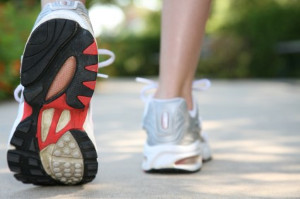
 Peripheral artery disease (PAD), a condition characterized by poor circulation to the lower extremities, often has no symptoms. However, when symptoms do become apparent, the first one is usually intermittent claudication. Claudication is a painful type of cramping that occurs in the hips, thighs, or calves when you are walking, climbing the stairs, or exercising. This cramping is caused by too little blood flowing to the lower limbs, and typically goes away when you are at rest. Other symptoms of PAD can include leg pain, poorly healing foot wounds, a decrease in the temperature of your legs compared to the rest of the body, and poor nail and hair growth on the legs. If you are experiencing any of these symptoms, it is suggested that you visit a podiatrist, who can screen you for PAD.
Peripheral artery disease (PAD), a condition characterized by poor circulation to the lower extremities, often has no symptoms. However, when symptoms do become apparent, the first one is usually intermittent claudication. Claudication is a painful type of cramping that occurs in the hips, thighs, or calves when you are walking, climbing the stairs, or exercising. This cramping is caused by too little blood flowing to the lower limbs, and typically goes away when you are at rest. Other symptoms of PAD can include leg pain, poorly healing foot wounds, a decrease in the temperature of your legs compared to the rest of the body, and poor nail and hair growth on the legs. If you are experiencing any of these symptoms, it is suggested that you visit a podiatrist, who can screen you for PAD.
Peripheral artery disease can pose a serious risk to your health. It can increase the risk of stroke and heart attack. If you have symptoms of peripheral artery disease, consult with Dr. Todd Goldberg from Complete Family Foot Care Center. Our doctor will assess your condition and provide you with quality foot and ankle treatment.
Peripheral artery disease (PAD) is when arteries are constricted due to plaque (fatty deposits) build-up. This results in less blood flow to the legs and other extremities. The main cause of PAD is atherosclerosis, in which plaque builds up in the arteries.
Symptoms
Symptoms of PAD include:
It is important to note that a majority of individuals never show any symptoms of PAD.
Diagnosis
While PAD occurs in the legs and arteries, Podiatrists can diagnose PAD. Podiatrists utilize a test called an ankle-brachial index (ABI). An ABI test compares blood pressure in your arm to you ankle to see if any abnormality occurs. Ultrasound and imaging devices may also be used.
Treatment
Fortunately, lifestyle changes such as maintaining a healthy diet, exercising, managing cholesterol and blood sugar levels, and quitting smoking, can all treat PAD. Medications that prevent clots from occurring can be prescribed. Finally, in some cases, surgery may be recommended.
If you have any questions, please feel free to contact our office located in Littlestown, PA . We offer the newest diagnostic and treatment technologies for all your foot care needs.